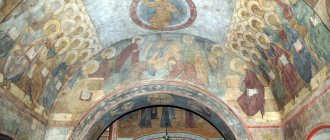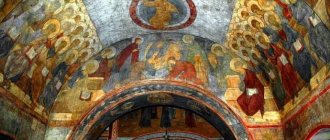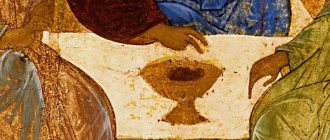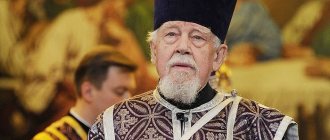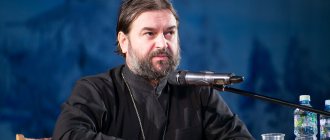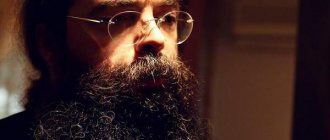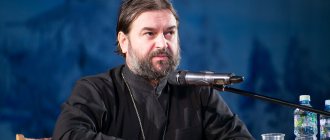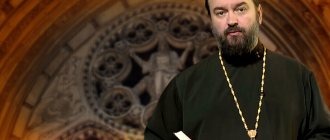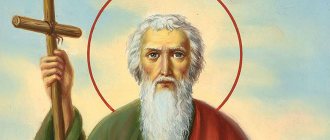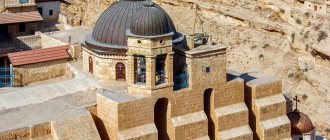History and attribution
According to the generally accepted version, the icons were found in 1918 in a barn at the Assumption Cathedral on Gorodok in Zvenigorod under a pile of firewood by the restorer of the All-Russian Commission for the Preservation and Revealing of Old Russian Painting G. O. Chirikov.
This message has the character of a legend. As noted by D. A. Sedov, an employee of the Zvenigorod Museum, there are no reports on this find, which was unusual for the work of the TSHR Commission, and the history of the discovery of icons in the barn is known from the report of N. D. Protasov and the publications of I. E. Grabar. In addition, the date of receipt of the icons at the Kremlin restoration workshops (October 8, 1918) does not coincide with the period of the Central State Historical Museum expedition to Zvenigorod, which began on October 14. According to the Tretyakov Gallery archive, after the discovery of the Zvenigorod rank, a search was undertaken for the missing Deesis icons: on December 21, N.D. Protasov visited the Korallovo estate near Zvenigorod in connection with information about the possible arrival of ancient icons from the Assumption Cathedral in the local church.
At a conference dedicated to the 1000th anniversary of the baptism of Rus', the head of the sector of the history of ancient Russian art of the Institute of Art History, Doctor of Historical Sciences O. I. Podobedova said that the icons of the Zvenigorod rank were not discovered by restorers: they were given to them by priest Dmitry Krylov:
| Father Dmitry acted solely at his own peril and risk, without the blessing of the dean or bishop. An act of this kind in the poorly educated clerical environment of a provincial parish could lead to undesirable consequences for him. The young priest, who was in Zvenigorod, apparently on an internship, immediately began to have troubles. In order not to completely ruin his life, the above legend was invented - especially for publication. |
CONTENTS Zvenigorod rank
of Christ Pantocrator
archangel Michael
Apostle Paul
The icons of the Zvenigorod rank were uncovered by specialists of the Commission for the Preservation and Disclosure of Ancient Painting in 1918-1919. and transferred to the State Historical Museum, from which they entered the collection of the Tretyakov Gallery in 1930.
In 1926, I. E. Grabar in the journal “Issues of Restoration” published an article “Andrei Rublev: An Essay on the Artist’s Creativity Based on the Data of Restoration Works of 1918-1925,” in which he attributed the Zvenigorod rank as the work of Andrei Rublev based on the features of painting that are related to the icons with Rublev’s Trinity and frescoes of the Assumption Cathedral in Vladimir. Despite the brevity of Grabar’s argument, his attribution “has received universal recognition” and most other art historians agree with him, recognizing the icons of the Zvenigorod rank as “undoubtedly belonging to Andrei Rublev.”
Various researchers date the Zvenigorod rank from the end of the 14th century to the 1420s. According to Academician V.N. Lazarev, “in terms of its style, this is such a mature work that it cannot be attributed to the early period of Rublev’s work. It could have arisen only after the painting of the Vladimir Assumption Cathedral, in other words, after 1408.” He dates the Zvenigorod rank to 1410-1415. He is supported by M.A. Ilyin (c. 1417), K. Onash (c. 1409) and other researchers.
Researchers note that based on the size of the icons of the Zvenigorod rank, it was intended for a very large unknown church and, based on the measurements, this is neither the Assumption Cathedral on Gorodok, nor the Cathedral of the Nativity of the Virgin Mary of the Savvino-Storozhevsky Monastery in Zvenigorod. At the same time, according to the inventory of the Assumption Cathedral in Gorodok in 1693, in the local row of the 17th century iconostasis and along the pillars there was part of the icons of a certain ancient Deesis order.
Trinity
Icon 1410 - 1420s, Linden board, wire, gesso, egg tempera, 314 x 220 cm State Tretyakov Gallery
The plot of “Trinity” is based on the biblical story of the appearance of deity to righteous Abraham in the form of three beautiful young angels. Abraham and his wife Sarah treated the strangers under the shade of the Mamre oak, and Abraham was given to understand that the deity in three persons was embodied in the angels. Since ancient times, there have been several options for depicting the Trinity, sometimes with details of the feast and episodes of the slaughter of a calf and the baking of bread (in the gallery’s collection these are 14th-century Trinity icons from Rostov the Great and 15th-century icons from Pskov). In the Rublev icon, attention is focused on the three angels and their condition. They are depicted seated around a throne, in the center of which is the Eucharistic chalice
with the head of a sacrificial calf, symbolizing the New Testament lamb, that is, Christ.
The meaning of this image is sacrificial love. The left angel,
signifying God the Father, blesses the cup with his right hand.
The middle angel (Son),
depicted in the gospel clothes of Jesus Christ, with his right hand lowered onto the throne with a symbolic sign, expresses submission to the will of God the Father and readiness to sacrifice himself in the name of love for people.
The gesture of the right angel (the Holy Spirit)
completes the symbolic conversation between the Father and the Son, affirming the high meaning of sacrificial love, and comforts the doomed to sacrifice. Thus, the image of the Old Testament Trinity (that is, with details of the plot from the Old Testament) turns into the image of the Eucharist (the Good Sacrifice), symbolically reproducing the meaning of the Gospel Last Supper and the sacrament established at it (communion with bread and wine as the body and blood of Christ). Researchers emphasize the symbolic cosmological significance of the compositional circle, into which the image fits laconically and naturally. In the circle they see a reflection of the idea of the Universe, peace, unity, which embraces multiplicity and cosmos. When comprehending the content of the Trinity, it is important to understand its versatility. The icon was in the Trinity Cathedral of the Trinity Monastery, which later became a monastery, until the twenties of our century. During this time, the icon underwent a number of renovations and copy-pasting https://rublev.voskres.ru/article.htm> STORY
The “Trinity” of Andrei Rublev is what is said in the first conciliar letter of the Apostle John: “For three testify in heaven: the Father, the Word and the Holy Spirit; and these three are one. And three bear witness on earth: spirit, water and blood; and these three are about one.” The earthly mixture of the Trinity through the spirit rushes to the Holy Spirit, and comes into contact with the heavenly Trinity, and is nourished by It, and water and blood are therefore saturated with unearthly grace, and feed with it the earthly world, nature itself - this is what the tree written by the Master says, as if we today they expressed themselves, in the background, behind and above the wing of the middle Angel; the sacrificial cup on the table also reminds us of the same thing. Two thin, as if drawn by a brush, seams, interrupted in the clothes and wings, cross the “Trinity”, one seam passes through the closure of the wings of the left and middle Angels, the second through the halo of the right Angel - the “Trinity” is written on three boards collected into one, the trinity has taken place and in this... And in the background (again, non-existent in icons) plan in the upper corner, the Master depicted a completely non-cult structure, like the outskirts of a certain city, and it, like a tree, appealed to the reality of a certain relief, a corner of the Russian land, overshadowed by a stay in it angelic trinity; it had to be sought and recognized... Every famous river in Russia is a borderland: about the population (sometimes condensing it to the people) they could say “Trans-Volga” or “Zaoksky”, or “Zadvinsky”, and our Trans-Urals were understood as a certain side, vastness and scope superior to other European countries. This river, on the steep slope of which I found myself in those years, divided this land into the northern forest region, studded with ancient cities and settlements, and the southern forest region, which hid equally ancient villages and towns in its forests. The river was called Klyazma, and behind me stood both Vladimir cathedrals of the 12th century, the Assumption and Dmitrievsky, and I aimed to get into the first of them, waiting for it to be opened. In the meantime, I stood on the edge of the steepness and looked at the distances of Zaklyazma, as one looks at a picturesque plan before setting off on a journey to the places chosen by one’s inspiration. The cathedral opened for mass, and only after the small flock had entered and scattered inside its multi-pillar complex, spherical space flowing into each other, I penetrated into the thick darkness, bursting with candle light, and, rather again on a whim, made my way to the low side vaults , and there, very close (extend your hand and touch the foot of one wandering to the Last Judgment), he found himself in front of frescoes painted exactly 600 years ago by the Master; another fresco depicted “The Procession of the Righteous to Paradise...” Behind me I heard a frequent, hidden whisper, and looked back; the young woman, bowing, said a prayer to “those marching to heaven”; Next to her stood a boy of about ten years old - a thin, pale face of a young cherub, wide eyes, an unblinking gaze; when he looked at me, something moved in his eyes, on his face appeared - no, not a smile, but a glimpse of some other, unfamiliar attention to me, as if we had met and seen each other, having flown into this ancient monastery forgotten by earthlings from different worlds, and, touching the reminders of the Last Judgment and the procession of the righteous to paradise, wished each other to find a third path, to the light of the Savior in strength... According to the actions of Rublev, four cities are known in which the Master lived as a monk and worked - Sergiev Posad, Vladimir , Zvenigorod and Moscow. Where Andrei Rublev was born is unknown to Russian history. But one day, during the intermission of a play about another brilliant artist (“Van Gogh” at the Ermolova Theater), I accidentally overheard a conversation between two metropolitan humanists, and in the conversation, in two or three sentences, a version flashed through Radonezh as the hypothetical homeland of a Chernets icon painter, and something , which is called Radonezh, is located... And I immediately, the next day, rushed by train to Abramtsevo and walked from there in search of Radonezh, who had disappeared in the flames of the same story, and found his remains on the banks of a cozy river: a church with a bell tower dating back to the 17th century, low earthen ramparts (what remains of the fortress wall), nearby in a spruce forest there is a miniature ancient cemetery, touched by the autumn yellowness of the birch trees in its depths; everything was familiar from the landscapes of Levitan, Nesterov, Romadin, Gritsai... and through them stretched the memory of this modest grace of our land, unknown to the beginning, reaching out to the one for whom I made my way here... And the thought-feeling that in this deserted corner at this hour On the Russian land, human life arose, lasting as the life of the spirit for more than six centuries, bent me to the ground, to the soft, meadow grass on the slope of the rampart, to the dark, winding water in the river, to the swaying reflections of black spruce trees... Rublev is an artist of autumn... light , poured in the “Trinity” over the figures of Angels, on the table around the sacrificial cup, illuminating the walls of the building and the sky above the tree, we saw the golden autumn time before sunset. From Radonezh the “Sofia path” led to the burial place of Andrei Rublev, to the Andronikov Monastery; there, near the Spassky Cathedral, at the end of the winter of 1430, Elder Andrei was buried. At that time, the monastery was still at a distance from the throne and lived according to the rules brought from the Sergius Monastery. The appearance of the monastery was bright and clean, like a Sunday child, this is how it is reflected in the waters of the Yauza; This is how it appears even now, when you move towards it either from the Kursky Station, or from Taganskaya Square and enter through the arched gates of the monastery, as if you are crossing the border of centuries, as if... The last time this happened was four years ago. I then introduced my wife to Moscow, which I knew and loved; but Moscow in the summer of that year was abuzz with terrorist attacks on transport. On the streets, in underground passages, and in the subway, patrols herded the public, tracking down suspicious people and searching those they didn’t like right before their eyes. Armed men in morgue uniforms filled the urban landscape with an unclear threat, an unconscious desire to return to a landscape in which they were not; and I took my wife to a white-walled monastery with graceful turrets and a cathedral hiding the ashes of the great Bogomas of the time of the monk. We crossed the cozy square and entered the silence ringed by the monastery walls; Inside this white silence we were greeted by a young mother with a baby in a stroller, and the wife exclaimed: “How wonderful it is here!” We walked in a circle formed by the gravity field of the ancient cathedral and the perimeter of the wall buildings; the cathedral stood closed, impenetrable, a thing in itself, keeping those coming at a distance from the lawn, and there was no thought of breaking this containment. We sat down on a bench, and when I began to draw the cathedral, my wife curled up next to me and instantly fell asleep. I painted the cathedral as I paint a rocky peak in the mountains, as a monolith that conquered the sky, freed from earthly futility. I was drawing, my wife was sleeping, a young mother and child were slowly repeating our circle, and after her, also slowly, a burly riot policeman was advancing, and I felt that he was aimed at us, I did not wake up my wife. “Tired?” – the riot policeman asked, approaching us and delicately looking at my drawing. “There is a little,” I answered, involuntarily increasing the energy of drawing; the wife smiled, she was awake, but did not open her eyes. “How wonderful it is here!” – she whispered. “I see,” said the riot policeman and went to catch up with the mother with the stroller. The capital was vigilant. It took an effort to return to the thought of time imprisoned in the stones of the cathedral, and time burning outside the walls of the monastery. The one whose ashes are hidden under this lawn (it is known that in the last century an ancient bell tower stood over the grave of a genius, but its trace is lost), probably thought least of all about Time, for in his creations there is no origin and no disappearance: the view of the Savior - inexhaustible, the wondrous sadness of the “Trinity” is inescapable... The sun hung exactly above the cathedral, and that is why it stood without a single shadow.
Description
The Zvenigorod rank is written on large boards (158-160 by 108-110 cm), the half-length images on it exceed human measure. Based on the traditional iconography of the Deesis, initially the Zvenigorod tier (except for the three surviving icons) could also include the icons “Our Lady”, “John the Baptist”, “Archangel Gabriel”, “Apostle Peter”, “Basily the Great” and “John Chrysostom”.
According to academician V.N. Lazarev, the icons “at first glance amaze with the extraordinary beauty of their cold, light colors. Blue, pink, indigo, faded violet and cherry tones are given in such impeccably correct combinations with the gold background that purely musical associations involuntarily arise in those contemplating the icon.” According to M. V. Alpatov, during the creation of the Zvenigorod rank, Rublev’s talent as a colorist was revealed:
| Russian icon painting before Rublev did not know such a wealth of shades and halftones. Byzantine icon painting did not know it either. |
Christ Pantocrator
The painting on the icon of Christ Pantocrator has survived in fragments. This is the most damaged of the icons of the Zvenigorod rank. On the face there is a crack along the old gesso, on the hair and beard there are abrasions of the top paint layer. An expert on ancient Russian art N.A. Demina notes that the Savior on Rublev’s icon is
| ...the embodiment of typically Russian good looks. Not a single element of the face is overly emphasized - everything is proportional and consistent: he is Russian, his eyes are not exaggerated, his nose is straight and thin, his mouth is small, the oval of his face, although elongated, is not narrow, there is no asceticism at all, his head has a thick mass of hair rises with calm dignity on a strong, slender neck. The most significant thing about this new look is the look. It is directed directly at the viewer and expresses lively and active attention to him; he feels a desire to delve into a person’s soul and understand him |
The gospel in the hand of the Savior is lost. Based on the surviving fragments of the codex in the hand of the Apostle Paul, it is assumed that on the icon of the Savior it was very large and occupied a significant place in the composition of the Deesis. Professor V.A. Plugin suggests that the inscription in the opened Gospel was associated with the theme of the Last Judgment. Based on the stylistic similarity with the 15th century icon of the Pantocrator from the Trinity-Sergius Lavra (located in the Tretyakov Gallery collection), which is close in time to the Zvenigorod Savior, a possible text option is “Come to Me, all you who labor and are heavy laden, and I will give you rest...” (Matthew 11 :28-29), which at first is not found in ancient Russian art and became characteristic only of the works of the 15th-16th centuries.
Academician V.N. Lazarev notes that the icon of the Savior shows a good knowledge of the tradition of Byzantine painting of the 14th century, but the image is devoid of Byzantine severity - in Andrei Rublev, “the image of Christ is so humanized that it completely loses its abstract cult character.”
"They were begged"
Monk Andrei was one of Sergiev’s many “chicks of the nest”, a direct successor of his prayerful exploits and service to his neighbor, which meant the entire Orthodox people of Rus'. It is not surprising that in the 1420s the already venerable elder Andrei was called from Moscow to the Trinity Monastery, where a great event took place. Sergius of Radonezh is glorified as a saint, and his newfound relics are transferred to the new stone Trinity Church. Prince Yuri Zvenigorodsky again acted as trustee of the construction. But the sovereign icon painters Andrei Rublev and Daniil Cherny received the order for painting the temple and its iconostasis not from him, but from the Trinity abbot Nikon. “The Legend of the Holy Icon Painters” testifies that “wonderful virtuous elders and painters” were “begged” by Nikon to take on this great work. And he adds: both icon painters “were formerly in obedience to the Monk Nikon.” From this detail we know that Andrei and Daniel were once listed as monks of the Sergius Monastery, after the death of Sergius himself (in 1392). And in another source, Daniel is called Andrei’s teacher. Most likely, this was the spiritual guidance of an older, more experienced monk by a younger, novice monk. After all, both were icon painters and, probably, when Andrei appeared in the monastery, they immediately “found” each other, shared one cell for two, worked together, fasted and prayed - until the end of their lives.
Angel. Miniature of Andrey Rublev. Gospel of Khitrovo, XIV century.
Why did Abbot Nikon have to beg them? Both were already old. Perhaps they were overcome by infirmities and illnesses. Or maybe in the last years of their lives they intensified their prayer work, completing or significantly limiting their artistic work. But it is precisely this detail - “they were begged for” - that suggests that Rublev’s creative flowering and maturity as an icon painter were left behind. After all, an artist who still feels the creative forces within himself and has not said the “most important thing” cannot refuse work that allows him to express precisely this “most important thing.” The main thing for Rublev was his “Trinity”. And it was not born in the mid-1420s, as this icon was previously dated, but earlier. The new “praise” to Sergius from the famous icon painters was the Church of the Holy Trinity, painted and decorated under their leadership. A crowded team of artists was involved in this work. Andrei and Daniil only controlled this “choir”, in which each of the talented icon painters, gathered from everywhere by Nikon, led his own part. Rublev was responsible for the overall design and drawing of the compositions in this iconostasis: most likely, he acted here as a flag bearer, i.e., he outlined the design of the icons. But not only. For example, the icon “The Appearance of an Angel to the Myrrh-Bearing Women” definitely says that Rublev also created new, previously unprecedented iconographic subjects.
The Trinity iconostasis can still be seen in the cathedral. This is the only iconostasis associated with the name of Andrei that has reached us in its entirety. But the frescoes were knocked down and rewritten in the 17th century. One can only hope with confidence that the later paintings repeat the layout and composition of the murals of the 1420s.
archangel Michael
Archangel Michael is depicted in iconography found in Byzantine painting from the beginning of the 14th century. In terms of the nature of the image, it is close to the angels on the frescoes of the central nave of the Assumption Cathedral in Vladimir. The icon has lost gold on the angel's chest, and there are traces of scratches on the face.
The Archangel is dressed in a shining azure tunic, almost completely hidden by the folds of a “swirling” pink cloak. The head is gently tilted to the right, brown curly hair is tied with a ribbon to match the chiton. Art critic M.V. Alpatov notes:
| In his half-figure, outlined by smooth, softly flowing contours, there is so much human charm, as if in his earthly appearance he had found the highest bliss and he does not know the desire for the “heavenly” world. |
Apostle Paul
The Apostle Paul is depicted slightly bending towards the Savior. His face is painted in more relief compared to other icons of the Zvenigorod rank. It has been suggested that it was written not by Andrei Rublev, but by his student. The face of the apostle is filled with sorrow and peace. To emphasize his contemplative image, the clothes are painted in silver and pearl tones. Both hands of the Apostle Paul hold a large, slightly open codex.
M. V. Alpatov writes about the icon of the Apostle Paul:
| This sage with a high open forehead bows his head not so much because he prays to Christ, but because he is immersed in thought. The soft flow of wide-arched contours emphasizes harmony and completeness in its appearance. |
Andronikov Monastery
Carrying out commissioned works in different places of the Moscow land, monks Andrei and Daniil invariably returned to their native Spaso-Andronikov Monastery on the Yauza. Now it is almost the center of the capital, but then Moscow was located within the current Boulevard Ring and the Andronikov monastery was a suburb. The life of Sergius of Radonezh (involved in the establishment of this monastery) depicts the monk Andrei as an honest elder who enjoys honor and authority in the monastery. He was one of the “cathedral elders” who, together with the abbot, managed the life of the monastic community. It was Andrei who in 1427 became one of the inspirers of the construction of the stone Spassky Cathedral in the monastery. As V.A. Plugin writes, Rublev “played the role of not only the leading master - performer of artistic works, but also a kind of ideologist who determined much in the system and structure of the ensemble” of the cathedral.
The repose of the icon painter Andrei Rublev in the Andronikov Monastery. Book miniature
The Andronikov Monastery itself, which now houses a museum named after the great icon painter, is a place of peace and quiet. Slowly walking around the temple, darkened by time, but still just as beautiful and picturesque, you can imagine how the hand of the humble monk Andrei touched these stones. How he sat on the platform above the entrance to the temple and painted his last work - the image of the Savior Not Made by Hands (as depicted in a 17th-century miniature). And how, having already left this temporary life, “in a blaze of glory” he appeared in the cell of the ill Daniel, calling him to “eternal and endless bliss...”.
